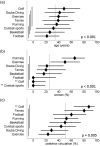Cervical artery dissection after sports - An analytical evaluation of 190 published cases
- PMID: 31008325
- PMCID: PMC6453193
- DOI: 10.1177/2396987317720544
Cervical artery dissection after sports - An analytical evaluation of 190 published cases
Abstract
Introduction: Cervical artery dissections may be preceded by mechanical trigger events, often related to sports.
Methods: Using the MEDLINE database, we identified case reports and case series of sports-related cervical artery dissections. Information of the type of sport, age and gender of the patient, affected vessels, associated infarction, time delay, and neurological sequelae were extracted. Demographic and clinical characteristics were compared between sport groups using analysis of variance and Chi square tests. Differences were further assessed with adjusted post hoc tests and homogenous subsets.
Results: A total of 115 reports describing 190 patients with cervical artery dissections related to 45 different sports were identified. The mean age of all patients was 35 years; 26% of all patients were women. Anterior and posterior circulation, as well as left and right side were affected with similar frequency. Patients belonging to different sport categories differed significantly with regard to age (p < 0.001), gender (p < 0.001), and affected circulation (anterior vs. posterior, p = 0.02). The posterior circulation was most often affected in golf players (88%) and least often in individuals engaging in exercise (23%) and scuba divers (29%). Laterality (left vs. right) and mortality were similar between sport groups.
Discussion: We performed a comprehensive review and analytical evaluation of case reports describing patients with cervical artery dissections after sport. Confirmation of our findings in prospective studies is needed.
Conclusion: Cervical artery dissection has been described in relation to a wide variety of sports. The risk of injury to particular neurovascular structures may depend on the type sport involved. Discipline-specific incidence rates are not known.
Keywords: Stroke; athletic injuries; brain infarction; carotid artery dissection; sports; vertebral artery dissection.
Conflict of interest statement
The author(s) declared no potential conflicts of interest with respect to the research, authorship, and/or publication of this article.
Figures


References
-
- Bejot Y, Daubail B, Debette S, et al. Incidence and outcome of cerebrovascular events related to cervical artery dissection: the Dijon Stroke Registry. Int J Stroke 2014; 9: 879–882. - PubMed
-
- Lee VH, Brown RD, Jr, Mandrekar JN, et al. Incidence and outcome of cervical artery dissection: a population-based study. Neurology 2006; 67: 1809–1812. - PubMed
-
- Debette S, Leys D. Cervical-artery dissections: predisposing factors, diagnosis, and outcome. Lancet Neurol 2009; 8: 668–678. - PubMed
-
- Leys D, Bandu L, Henon H, et al. Clinical outcome in 287 consecutive young adults (15 to 45 years) with ischemic stroke. Neurology 2002; 59: 26–33. - PubMed
-
- Engelter ST, Grond-Ginsbach C, Metso TM, et al. Cervical artery dissection: trauma and other potential mechanical trigger events. Neurology 2013; 80: 1950–1957. - PubMed
LinkOut - more resources
Full Text Sources

